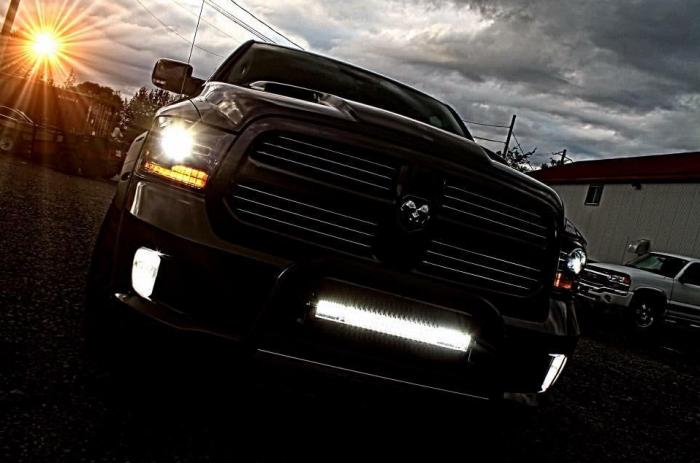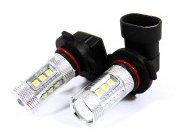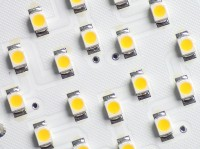ADVANTAGES OF LED LIGHTS FOR YOUR VEHICLE
- 2016-02-22

ADVANTAGES OF LED LIGHTS FOR YOUR VEHICLE
Upgrading your automotive lights can provide substantial benefits such as increased visibility and safety while driving at night. In the last several years, LED lights have emerged as a popular upgrade to stock halogen light bulbs. What makes an LED light bulb better than your original equipment? We’ll examine the advantages below.
What is an LED Light Bulb?
 Light bulbs have followed a similar style of construction since their invention: a filament inside of an enclosed glass envelope containing some kind of gas. When the filament receives power, it burns and produces illumination. Compared to other light bulb designs, they are relatively inexpensive to produce. For this reason, vehicles are usually equipped with halogen light bulbs which are constructed with this traditional design.
Light bulbs have followed a similar style of construction since their invention: a filament inside of an enclosed glass envelope containing some kind of gas. When the filament receives power, it burns and produces illumination. Compared to other light bulb designs, they are relatively inexpensive to produce. For this reason, vehicles are usually equipped with halogen light bulbs which are constructed with this traditional design.
 LED stands for light emitting diode. Rather than a filament burning in a gas-filled chamber, LEDs produce light when sufficient voltage is applied to the leads on the diode, resulting in illumination through a process called electroluminescence. Explaining this process would be an article in itself, but its benefits as an alternative to traditional light sources are easy to explain.
LED stands for light emitting diode. Rather than a filament burning in a gas-filled chamber, LEDs produce light when sufficient voltage is applied to the leads on the diode, resulting in illumination through a process called electroluminescence. Explaining this process would be an article in itself, but its benefits as an alternative to traditional light sources are easy to explain.
Efficiency
Perhaps the most important advantage an LED light bulb has over a traditional light bulb is its innate efficiency in converting electricity into visible light. A traditional light bulb only turns approximately 3% of the electricity it receives into visible light. The remaining 97% becomes heat energy which does nothing to help with illumination. On the other hand, an LED light converts about 90% of the energy it receives into visible light with only 10% given off as heat waste. This means that an LED light bulb can produce substantially more illumination per watt than a comparable halogen bulb
Long Lasting
 A bulb uses a filament contained within a gas inhibitor to resist incoming current, creating light as a byproduct of that resistance. Why does that matter? Essentially, the filament is on fire inside of that contained system. If there is anything impacting how it burns — whether conditions be too hot or too cold — the traditional bulb will fail and need to be replaced. While halogen technology has advanced to the point that this filament can last upwards of 1500 hours, LED lights far exceed this lifespan. The reason for this is that an LED does not require an additional inhibitor to prevent itself from burning up. The semiconductors that comprise the diode itself act as the inhibitor. The only other regulator it needs (other than the semiconductor) is the amount of current. This is one of the easiest elements of an electrical system to control and by far the most predictable. The result is a design that is less prone to failure and which has an extremely long lifespan,
A bulb uses a filament contained within a gas inhibitor to resist incoming current, creating light as a byproduct of that resistance. Why does that matter? Essentially, the filament is on fire inside of that contained system. If there is anything impacting how it burns — whether conditions be too hot or too cold — the traditional bulb will fail and need to be replaced. While halogen technology has advanced to the point that this filament can last upwards of 1500 hours, LED lights far exceed this lifespan. The reason for this is that an LED does not require an additional inhibitor to prevent itself from burning up. The semiconductors that comprise the diode itself act as the inhibitor. The only other regulator it needs (other than the semiconductor) is the amount of current. This is one of the easiest elements of an electrical system to control and by far the most predictable. The result is a design that is less prone to failure and which has an extremely long lifespan,
often in excess of 25,000 hours.
Ruggedness
Since an LED light eschews the traditional glass bulb format, it is considerably more damage resistant than traditional lights and can, therefore, endure more punishment from vibration, impacts, and other environmental hazards. It is for this reason that off-road vehicles are often equipped with LED light bars. Where halogen and HID light bulbs would be prone to frequent breaking due to the rigors of off-road travel, the sturdy LED light can withstand abuse and keep on shining.
Hits: 【Print】